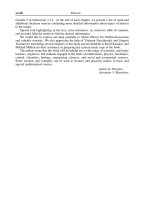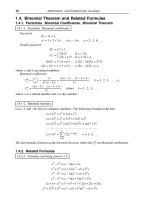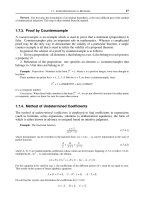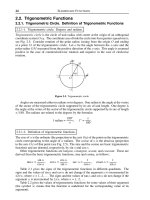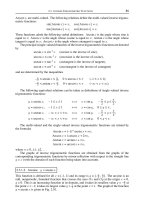Handbook of mathematics for engineers and scienteists part 19 potx
Bạn đang xem bản rút gọn của tài liệu. Xem và tải ngay bản đầy đủ của tài liệu tại đây (362.03 KB, 7 trang )
94 ANALYTIC GEOMETRY
4.3.2-4. Angle between two straight lines.
We consider two straight lines given by the equations
y = k
1
x + b
1
and y = k
2
x + b
2
,(4.3.2.5)
where k
1
=tanϕ
1
and k
2
=tanϕ
2
are the slopes of the respective lines (see Fig. 4.17). The
angle α between these lines can be obtained by the formula
tan α =
k
2
– k
1
1 + k
1
k
2
,(4.3.2.6)
where k
1
k
2
≠ –1.Ifk
1
k
2
=–1,thenα =
1
2
π.
Remark. If at least one of the lines is perpendicular to the axis OX, then formula (4.3.2.6) does not make
sense. In this case, the angle between the lines can be calculated by the formula
α = ϕ
2
– ϕ
1
.(4.3.2.7)
X
y=k x+b
y=k x+b
1
2
1
2
1
2
φ
α
φ
Y
O
Figure 4.17. Angle between two straight lines.
The angle α between the two straight lines given by the general equations
A
1
x + B
1
y + C
1
= 0 and A
2
x + B
2
y + C
2
= 0 (4.3.2.8)
can be calculated using the expression
tan α =
A
1
B
2
– A
2
B
1
A
1
A
2
+ B
1
B
2
,(4.3.2.9)
where A
1
A
2
+ B
1
B
2
≠ 0.IfA
1
A
2
+ B
1
B
2
= 0,thenα =
1
2
π.
Remark. If one needs to find the angle between straight lines and the order in which they are considered
is not defined, then this order can be chosen arbitrarily. Obviously, a change in the order results in a change in
the sign of the tangent of the angle.
4.3. STRAIGHT LINES AND POINTS ON PLANE 95
4.3.2-5. Point of intersection of straight lines.
Suppose that two straight lines are defined by general equations in the form (4.3.2.8).
Consider the system of two first-order algebraic equations (4.3.2.8):
A
1
x + B
1
y + C
1
= 0,
A
2
x + B
2
y + C
2
= 0.
(4.3.2.10)
Each common solution of equations (4.3.2.10) determines a common point of the tow lines.
If the determinant of system (4.3.2.10) is not zero, i.e.,
A
1
B
1
A
2
B
2
= A
1
B
2
– A
2
B
1
≠ 0,(4.3.2.11)
then the system is consistent and has a unique solution; hence these straight lines are distinct
and nonparallel and meet at the point A(x
0
, y
0
), where
x
0
=
B
1
C
2
– B
2
C
1
A
1
B
2
– A
2
B
1
, y
0
=
C
1
A
2
– C
2
A
1
A
1
B
2
– A
2
B
1
.(4.3.2.12)
Condition (4.3.2.11) is often written as
A
1
A
2
≠
B
1
B
2
.(4.3.2.13)
Example 2. To find the point of intersection of the straight lines y = 2x – 1 and y =–4x + 5,wesolve
system (4.3.2.10):
2x – y – 1 = 0,
–4x – y + 5 = 0,
and obtain x = 1, y = 1. Thus the intersection point has the coordinates (1, 1).
4.3.2-6. Condition for straight lines to be perpendicular.
For two straight lines determined by slope-intercept equations (4.3.2.5) to be perpendicular,
it is necessary and sufficient that
k
1
k
2
=–1.(4.3.2.14)
Relation (4.3.2.14) is usually written as
k
1
=–
1
k
2
,(4.3.2.15)
and one also says that the slopes of perpendicular straight lines are inversely proportional
in absolute value and opposite in sign.
If the straight lines are given by general equations (4.3.2.8), then a necessary and
sufficient condition for them to be perpendicular can be written as (see Paragraph 4.3.2-4)
A
1
A
2
+ B
1
B
2
= 0.(4.3.2.16)
Example 3. The lines 3x+y–3 =0 and x–3y+8 = 0 are perpendicularsince theysatisfycondition(4.3.2.16):
A
1
A
2
+ B
1
B
2
= 3 ⋅ 1 + 1 ⋅ (–3)=0.
96 ANALYTIC GEOMETRY
4.3.2-7. Condition for straight lines to be parallel.
For two straight lines defined by slope-intercept equations (4.3.2.5) to be parallel and not
to coincide, it is necessary and sufficient that
k
1
= k
2
, b
1
≠ b
2
.(4.3.2.17)
If the straight lines are given by general equations (4.3.2.8), then a necessary and
sufficient condition for them to be parallel can be written as
A
1
A
2
=
B
1
B
2
≠
C
1
C
2
;(4.3.2.18)
in this case, the straight lines do not coincide (see Fig. 4.18).
X
b
b
1
2
φφ
Y
O
Figure 4.18. Parallel straight lines.
Example 4. The straight lines 3x + 4y + 5 = 0 and 3/2 x + 2y + 6 = 0 are parallel since the following
condition (4.3.2.18) is satisfied:
3
3/2
=
4
2
≠
5
6
.
4.3.2-8. Condition for straight lines to coincide.
For two straight lines given by slope-intercept equations (4.3.2.5) to coincide, it is necessary
and sufficient that
k
1
= k
2
, b
1
= b
2
.(4.3.2.19)
If the straight lines are given by general equations (4.3.2.8), then a necessary and
sufficient condition for them to coincide has the form
A
1
A
2
=
B
1
B
2
=
C
1
C
2
.(4.3.2.20)
Remark. Sometimes the case of coinciding straight lines is considered as a special case of parallel straight
lines and it not distinguished as an exception.
4.3.2-9. Distance between parallel lines.
The distance between the parallel lines given by equations (see Paragraph 4.3.2-7)
A
1
x + B
1
y + C
1
= 0 and A
1
x + B
1
y + C
2
= 0 (4.3.2.21)
can be found using the formula (see Paragraph 4.3.2-3)
d =
|C
1
– C
2
|
A
2
1
+ B
2
1
.(4.3.2.22)
4.4. SECOND-ORDER CURVES 97
4.3.2-10. Condition for a straight line to separate points of plane.
Suppose that a straight line in the Cartesian coordinate system OXY is given by an equation
of the form
Ax + By + C = 0.(4.3.2.23)
Obviously, this straight line divides the plane into two half-planes. We consider two arbitrary
points A
1
(x
1
, y
1
)andA
2
(x
2
, y
2
) of the plane that do not lie on the line. The points are said
to be nonseparated by the straight line if they belong to the same half-plane (lie on the
same side of the straight line and possibly coincide). The points are said to be separated by
the straight line if they belong to different half-planes (lie on opposite sides of the straight
line).
Two points A
1
(x
1
, y
1
)andA
2
(x
2
, y
2
) that do not belong to the straight line (4.3.2.23)
are separated by this line if and only if the numbers Ax
1
+ By
1
+ C and Ax
2
+ By
2
+ C
have opposite signs.
4.4. Second-Order Curves
4.4.1. Circle
4.4.1-1. Definition and canonical equation of circle.
A curve on the plane is called a circle if there exists a rectangular Cartesian coordinate
system OXY in which the equation of this curve has the form (see Fig. 4.19a)
x
2
+ y
2
= a
2
,(4.4.1.1)
where the point O(0, 0) is the center of the circle and a > 0 is its radius. Equation (4.4.1.1)
is called the canonical equation of a circle.
OO
M
N
XX
a
aa
a
YY
()a ()b
Figure 4.19. Circle.
The circle defined by equation (4.4.1.1) is the locus of points equidistant (lying at the
distance a) from its center. If a circle of radius a is centered at a point C(x
0
, y
0
), then its
equation can be written as
(x – x
0
)
2
+(y – y
0
)
2
= a
2
.(4.4.1.2)
The area of the disk bounded by a circle of radius a is given by the formula S = πa
2
.
The length of this circle is L = 2πa. The area of the figure bounded by the circle and the
chord passing through the points M (x
0
, y
0
)andN(x
0
,–y
0
)is(seeFig.19b)
S =
πa
2
2
+ x
0
a
2
– x
2
0
+ a
2
arcsin
x
0
a
.(4.4.1.3)
98 ANALYTIC GEOMETRY
4.4.1-2. Parametric and other equations of circle.
The parametric equations of the circle (4.4.1.1) have the form
x = a cos θ, y = a sin θ,(4.4.1.4)
where the angle in the polar coordinate system plays the role of the variable parameter (see
Paragraphs 4.2.1-4 and 4.2.1-5).
The equation of the circle (4.4.1.1) in the polar coordinate system has the form
ρ = a (4.4.1.5)
and does not contain the polar angle θ.
Remark. The form of the equation of a circle in a polar coordinate system depends on the choice of the
pole and the polar axis (see Example 7 in Subsection 4.2.1).
4.4.2. Ellipse
4.4.2-1. Definition and canonical equation of ellipse.
A curve on the plane is called an ellipse if there exists a rectangular Cartesian coordinate
system OXY in which the equation of the curve has the form
x
2
a
2
+
y
2
b
2
= 1,(4.4.2.1)
where a ≥ b > 0 (see Fig. 4.20). The coordinates in which the equation of an ellipse has the
form (4.4.2.1) are called the canonical coordinates for this ellipse, and equation (4.4.2.1)
itself is called the canonical equation of the ellipse.
OO
M
N
XX
b
aacc
b
YY
()a ()b
Figure 4.20. Ellipse.
The segments A
1
A
2
and B
1
B
2
joining the opposite vertices of an ellipse, as well as
their lengths 2a and 2b, are called the major and minor axes, respectively, of the ellipse.
The axes of an ellipse are its axes of symmetry. In Fig. 4.20a, the axes of symmetry of the
ellipse coincide with the axes of the rectangular Cartesian coordinate system OXY .The
numbers a and b are called the semimajor and semiminor axes of the ellipse. The number
c =
√
a
2
– b
2
is called the linear eccentricity, and the number 2c is called the focal distance.
The number e = c/a =
1 – a
2
/b
2
, where, obviously, 0 ≤ e < 1, is called the eccentricity
or the numerical eccentricity. The number p = b
2
/a is called the focal parameter or simply
the parameter of the ellipse.
4.4. SECOND-ORDER CURVES 99
The point O(0, 0) is called the center of the ellipse. The points of intersection A
1
(–a, 0),
A
2
(a, 0)andB
1
(0,–b), B
2
(0, b) of the ellipse with the axes of symmetry are called its
vertices. The points F
1
(–c, 0)andF
2
(c, 0)arethefocus of the ellipse. This explains why
the major axis of an ellipse is sometimes called its focal axis. The straight lines x = a/e
(e ≠ 0) are called the directrices.ThefocusF
2
(c, 0) and the directrix x = a/e are said to be
right, and the focus F
1
(–c, 0) and the directrix x =–a/e are said to be left.Afocusanda
directrix are said to be like if both of them are right or left simultaneously.
The segments joining a point M(x, y) of an ellipse with the foci F
1
(–c, 0)andF
2
(c, 0)
are called the left and right focal radii of this point. We denote the lengths of the left and
right focal radii by r
1
= |F
1
M
0
| and r
2
= |F
2
M
0
|, respectively.
Remark. For a = b (c = 0), equation (4.4.2.1) becomes x
2
+ y
2
= a
2
and determines a circle; hence a circle
can be considered as an ellipse for which b = a, c = 0, e = 0,andρ = 0, i.e., the semiaxes are equal to each
other, the foci coincide with the center, the eccentricity is zero (the directrices are not defined), and the focal
parameter is zero.
The area of the figure bounded by the ellipse is given by the formula S = πab. The length
of the ellipse can be calculated approximately by the formula L ≈ π
1.5 (a+b)–
√
ab
.The
area of the figure bounded by the ellipse and the chord passing through the points M(x
0
, y
0
)
and N (x
0
,–y
0
) is equal to (see Fig. 20b)
S =
πab
2
+
b
a
x
0
a
2
– x
2
0
+ a
2
arcsin
x
0
a
.(4.4.2.2)
4.4.2-2. Focal property of ellipse.
The ellipse defined by equation (4.4.2.1) is the locus of points on the plane for which the
sum of distances to the foci F
1
and F
2
is equal to 2a (see Fig. 4.21). We write this property
as
r
1
+ r
2
= 2a,(4.4.2.3)
where r
1
and r
2
satisfy the relations
r
1
=
(x + c)
2
+ y
2
= a + ex,
r
2
=
(x – c)
2
+ y
2
= a – ex.
(4.4.2.4)
OFF
X
aa
r
r
d
d
1
2
2
1
21
Y
M
0
2
1
φ
φ
Figure 4.21. Focal property of ellipse.
Remark. One can show that equation (4.4.2.1) implies equation (4.4.2.3) and vice versa; hence the focal
property of an ellipse is often used as its definition.
100 ANALYTIC GEOMETRY
4.4.2-3. Focus-directrix property of ellipse.
The ellipse determined by equation (4.4.2.1) on the plane is the locus of points for which
the ratio of distances to a focus and the like directrix is equal to e:
r
1
x +
a
e
–1
= e, r
2
x –
a
e
–1
= e.(4.4.2.5)
4.4.2-4. Equation of tangent and optical property of ellipse.
The tangent to the ellipse (4.4.2.1) at an arbitrary point M
0
(x
0
, y
0
) is described by the
equation
x
0
x
a
2
+
y
0
y
b
2
= 1.(4.4.2.6)
The distances d
1
and d
2
from the foci F
1
(–c, 0)andF
2
(c, 0) to the tangent to the ellipse
at the point M
0
(x
0
, y
0
) are given by the formulas (see Paragraph 4.3.2-4)
d
1
=
1
Na
|x
0
e + a| =
r
1
(M
0
)
Na
,
d
2
=
1
Na
|x
0
e – a| =
r
2
(M
0
)
Na
,
N =
x
0
a
2
2
+
y
0
b
2
2
,(4.4.2.7)
where r
1
(M
0
)andr
2
(M
0
) are the lengths of the focal radii of M
0
.
The tangent at an arbitrary point M
0
(x
0
, y
0
) of an ellipse forms acute angles ϕ
1
and ϕ
2
with the focal radii of the point of tangency, and
sin ϕ
1
=
d
1
r
1
=
1
Na
,sinϕ
2
=
d
2
r
2
=
1
Na
.(4.4.2.8)
This implies the optical property of the ellipse:
ϕ
1
= ϕ
2
,(4.4.2.9)
which means that all light rays issuing from one focus of the ellipse converge at the other
focus after the reflection in the ellipse.
4.4.2-5. Diameters of ellipse.
A straight line passing through the midpoints of parallel chords of an ellipse is called a
diameter of the ellipse. All diameters of an ellipse pass through its center. Two diameters
of an ellipse are said to be conjugate if their slopes satisfy the relation
k
1
k
2
=–
b
2
a
2
.(4.4.2.10)
Two perpendicular conjugate diameters are called the principal diameters of the ellipse.
Remark. If a = b, i.e., the ellipse is a circle, then condition (4.4.2.10) becomes the perpendicularity
condition: k
1
k
2
=–1. Thus any two conjugate diameters of a circle are perpendicular to each other, and each
of the diameters is a principal diameter.




